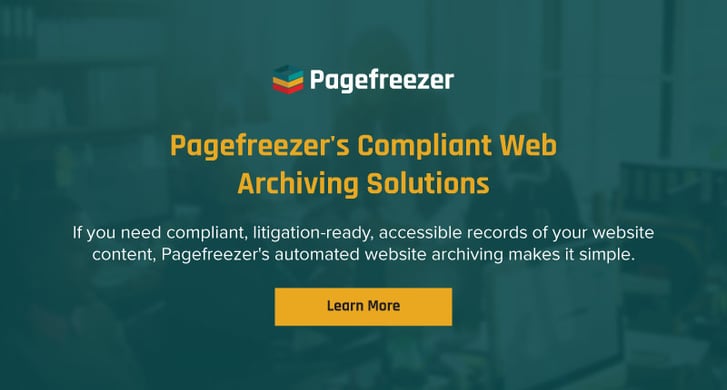If you’re trying to archive your website, whether for litigation readiness, corporate heritage, or you are just trying to make sure your website is compliant with your industry’s regulatory requirements, you will likely encounter a little ol’ file type called WARC (Web ARChive).
While WARC is a common file type in the world of web archiving, this may be your first time hearing about it. Don't let that fool you, because WARC has a rich history and its significance goes well beyond just archiving.
In this article, we’re going to cover the most important information you need to know about the WARC file format, its history, and why it’s going to become your best friend for website archive compliance.
Table of Contents
1. What is Warc?
2. The History of the WARC File Format
3. Benefits of the WARC File Format
4. Why is WARC Important for Regulatory Compliance?
5. Best Practices for Implementing WARC in Regulatory Compliance
What is Warc?
WARC (Web ARChive) is a file format specifically designed for web archives. It’s primarily used for the long-term preservation of digital data.
As you can imagine, storing a website is pretty complex. There’s a lot of data and content to capture if you want a proper archive. This is where WARC shines.
WARC files are created by a comprehensive crawling process, capturing an entire webpage in its original context, along with associated metadata, and even metadata on the crawl process itself. That means WARC files not only store the web page as it appeared on that specific day and time, but also capture all images, digital objects, metadata, file formats like PDF, MP3, HTML, JS, and CSS, and anything else a web browser would need to read to show the site content.
The beauty of the WARC file format is that it can represent all of this data exactly as if it was a live webpage, as it was when it was collected.
A Brief History: The Creation of the WARC File Format
The practice of web archiving started gaining traction in the early 2000s when organizations and libraries needed tools for safeguarding online content for research, historical, and cultural purposes.
In 2006, The International Internet Preservation Consortium (IIPC), whose mission is to identify and develop best practices for selecting, harvesting, collecting, preserving and providing access to Internet content, answered the call and started developing the WARC file format.
But WARC was not the first file format meant for archiving websites, and not even the first archiving file format used by the IIPC. In 1996, after discussions with the IIPC, Brewster Kahle and Mike Burner from the Internet Archive designed the ARCfile format.
And that was great…for a while. Back in 1996, websites were laughably simple compared to the complex and dynamic websites that would appear just 10 years later. As such, a new tool was needed. And so the WARC file format we know and love today was developed as an extension of the original ARCfile.
In May 2009, the WARC format was released as an ISO international standard (ISO 28500:2017). From there it found wider use for harvesting, accessing, mining, exchanging and preserving digital resources. Though it was created for web archiving, it has now been adopted to store a variety of digital materials.
Since then, the WARC format has had a few updates and revisions meant to improve its capabilities. Now it is the go-to format for the most preservation-oriented organizations in the world like the Library of Congress, The British Library, Bibliothèque Nationale de France, The National Library of Australia, and of course, the Internet Archive.
What's So Great About the WARC File Format?
The WARC format has a ton of advantages for archiving digital content:
1. WARC is Non-Proprietary
The WARC file format and its specifications are openly available to the public. This openness promotes interoperability and wider adoption since developers and organizations can freely implement the WARC format without being tied down by proprietary constraints.
2. WARC Is Widely Adopted
Being an international ISO standard ensures that various tools, software, and systems can effectively create, read, and process WARC files. This compatibility allows for seamless sharing of web archives.
3. WARC Will Be Accessible For a Long, Long Time
Being able to access records in the future is the point of archiving. As a standardized and widely used format, WARC files are likely to remain supported by software and systems over extended periods, ensuring that archived data remains accessible in the future.
As an ISO standard, WARC also undergoes periodic reviews to ensure it meets modern web archiving needs, meaning it’s always up-to-date.
4. WARC is Credible and Compliant
The adoption of WARC as a standard by reputable organizations like the Internet Archive and Library of Congress adds credibility to its use. The National Archives and Records Administration (NARA), the nation’s recordkeeper, adopted WARC as the only acceptable file format for the long-term preservation of website and social media records according to Bulletin 2014-04.
5. WARC Can Be Automated
The structured format of WARC files enables automated bulk harvesting, which is crucial as the number and complexity of websites grow exponentially.
5. WARC Can Preserve Complex and Dynamic Content
Websites change all the time. But whether it’s text, photos, videos, or animations, WARC files grab everything and can provide an accurate reproduction of the website on a specific day and time. Capturing dynamic content and representing it as it originally appeared is a very difficult process, but essential for compliance.
Why is WARC Important for Regulatory Compliance?
With the rapid rate of digital transformation across the business world, organizations are relying more heavily on online platforms and websites for communication and transactions. As such, regulatory bodies now emphasize preserving digital records to ensure accountability, transparency, and regulatory compliance.
This means WARC is now very important for regulatory compliance. With WARC as the international standard, the ability to create and present WARC files has become an expectation for compliance with many regulators.
Though we can’t cover every regulation in the world concerned with recordkeeping file formats, here are some of the most common scenarios where WARC files are crucial for compliance:
1. Regulation of Online Advertising and Marketing
Regulatory bodies are increasingly regulating online advertising and marketing. Preserving digital records of online marketing campaigns, including website content, is essential to verify compliance with advertising standards and consumer protection regulations.
WARC files store not only the web pages themselves but also associated metadata, ensuring that the archived data remains unchanged and tamper-proof over time. This integrity is crucial for compliance, when the accuracy and trustworthiness of records will be under scrutiny.
2. Financial Regulations
Regulatory bodies like the Securities and Exchange Commission (SEC) in the United States and similar authorities require financial institutions to preserve digital records related to communications (including website content) to ensure market integrity and investor protection.
Again, the integrity, completeness, and accessibility of these records is essential to compliance, making WARC the standard for archiving records in financial institutions.
3. Efficient Auditing
WARC files can be organized and indexed, making it easy to search for specific information within the archived content. Compliance often requires organizations to retrieve specific records promptly. WARC files' searchability ensures that organizations can quickly access and present the necessary information, aiding in regulatory inquiries or audits.
Best Practices for Implementing WARC in Regulatory Compliance
If you’re looking to implement a website archiving solution for compliance, legal, or historical purposes there are a number of things to consider:
1. Choose the Right Archiving Tools
Evaluation
Do your research! Ask questions! Make sure the web archiving tools you are evaluating support the WARC format. But also consider factors like ease of use, scalability, and customization.
Compatibility
Make sure whichever website archiving tool you choose is compatible with the specific types of websites and digital content your organization needs to archive. Some tools may handle complex websites or interactive content better than others.
Open Source vs. Commercial
Consider whether open-source or commercial archiving tools best suit your organization's needs. Open-source tools often provide flexibility and customization, but require very tech-savvy users. Often commercial solutions are the best option because they provide additional support and features that could help you with your eDiscovery and compliance efforts.
2. Ensure Data Security and Compliance
Absolutely make sure to implement encryption protocols to secure data during transmission and storage. Choosing the right archiving tool or provider can usually help with this.
Most importantly, always ensure that WARC files are securely transmitted and stored to prevent unauthorized access.
You must also understand and comply with all relevant data protection and recordkeeping regulations in your industry and country of business. Ensure that archived content, especially if it contains personal or sensitive data, is handled in accordance with legal requirements.
3. Establish Retention Policies
Determine appropriate retention periods for archived content based on regulatory requirements, organizational needs, and the significance of the content. Necessary retention periods may vary based on the content.
Set a time to review and update retention policies to ensure they align with changing regulations and organizational priorities. Delete content that is no longer required, in line with your established data retention policies.
4. Create Documentation
Maintain clear documentation of the archiving process, including tools used, parameters configured, and any issues encountered. Documentation helps in troubleshooting, auditing, and ensuring transparency in the archiving process.
5. Regularly Monitor and QA Test
Implement regular checks and monitoring procedures to ensure that the archiving system is functioning as intended. Schedule periodic crawls and checks to identify and address any issues promptly.
Make sure to perform quality assurance checks on archived content to ensure its completeness, accuracy, and integrity. Regularly validate WARC files to identify potential corruption or data loss.
6. Train Staff
Provide training to staff involved in the archiving process. Ensure that they understand the importance of proper archiving practices, compliance requirements and the significance of metadata. Foster awareness among staff about the organization's archiving policies.
6. Backup Regularly and Create Redundancy
Establish regular backup procedures for archived content, including WARC files and associated metadata. Implement redundant storage solutions to prevent data loss in case of hardware failures or other disasters. Consider storing backup copies of WARC files in offsite locations or cloud storage solutions to ensure disaster recovery capabilities.
Pagefreezer's WARC Export Capabilities
Pagefreezer’s WARC export capabilities automatically comply with NARA’s website recordkeeping guidelines. And now that we’ve covered everything you need to know about WARC files to stay compliant, we'd like to show you why Pagefreezer is the best solution for creating a compliant, secure archive. Click the image below to learn more.









